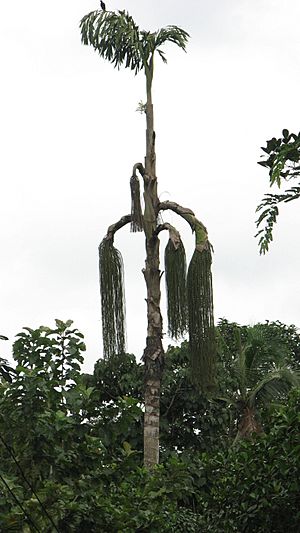Caryota urens facts for kids
Quick facts for kids Caryota urens |
|
|---|---|
 |
|
| Conservation status | |
| Scientific classification | |
| Genus: |
Caryota
|
| Species: |
urens
|
The Caryota urens is a type of palm plant. It is known by many names like solitary fishtail palm or kitul palm. This plant is originally from countries like Sri Lanka, India, Myanmar, and Malaysia. It grows in open fields and clearings in rainforests.
The name urens comes from Latin and means "stinging." This is because the fruit of this palm has chemicals that can irritate your skin. People also call it the jaggery palm or sugar palm because it can be used to make sweet products. In some places, its leaves are even used to make fishing rods!
What it Looks Like
The Caryota urens palm has a single, tall trunk. It can grow up to 18 meters (about 59 feet) high. Its trunk can be as wide as 30 centimeters (about 12 inches). The trunk is gray and has rings from old leaves.
At the top, the palm has a crown of leaves that can spread out 6 meters (about 20 feet) wide. The leaves are shaped like triangles and are bright to dark green. They are about 3.5 meters (about 11.5 feet) long. Each leaf has many smaller leaflets. These leaflets are about 30 centimeters (about 12 inches) long. They have one pointed edge and one jagged edge, which makes them look a bit like a fish's tail.
Long flower clusters, called inflorescences, grow from the palm. They can be up to 3 meters (about 10 feet) long. These clusters hang down and have white flowers. After the flowers, small, round fruits grow. Each fruit is about 1 centimeter (about 0.4 inches) wide and turns red when ripe. It contains one seed.
Be careful with the fruit! Like all Caryotas palms, its fruit contains oxalic acid. This can irritate your skin and mouth.
An interesting fact about these palms is that they are "monocarpic." This means they flower and produce fruit only once in their lifetime. After this process, the tree dies.
How People Use It
The Caryota urens palm is very useful to people. Its trunk has a lot of starch, which is a type of energy storage. A sweet juice can also be taken from the flower shoots. This juice can be boiled down to make a sugary syrup. The young inner part of the palm, called the "cabbage," can be eaten raw or cooked.
In Sri Lanka, this palm is called kithul (කිතුල්). It is famous for making kithul treacle. This is a thick, dark, sweet syrup that is special to Sri Lanka. People use kithul treacle to sweeten many dishes in both Sri Lankan and Western cooking.
A traditional drink called "toddy" is also made from the flower clusters. This drink is known to be quite strong. The soft inner part of the mature palm can be dried and ground into a powder. This powder is edible and tastes sweet. In some parts of India, this powder is thought to be cooling and healthy. In Sri Lanka, this powder is mixed with coconut milk and cooked to make a dish called Kithul Thalapa (කිතුල් තලප).
Even animals benefit from this palm. Elephants enjoy eating both the leaves and the inner pulp of the Caryota urens plant.
The leaves of the palm have strong fibers. These fibers are used to make baskets in Cambodia, where the plant is called tunsaè. The main part of the trunk contains a starch similar to sago, which is another food source. The trunk can also be used for building materials. The fruit, once its irritating hairs are removed, is sweet and pleasant to eat. People in Cambodia also cut the flower stalks to make sugar, which can then be used to make the traditional drink.
Where It Grows
The Caryota urens palm is often grown as an ornamental tree. This means it is planted in gardens and parks because it looks beautiful. It thrives in tropical and sub-tropical climates. When the plant is smaller, it can even be kept indoors as a houseplant.
Images for kids
See also
 In Spanish: Taquipán para niños
In Spanish: Taquipán para niños




